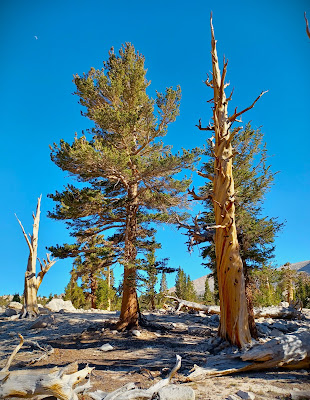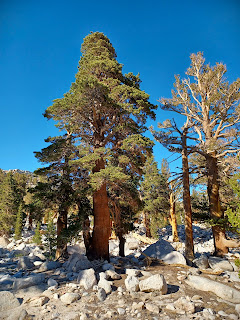Ascending Mount Langley: Reflections from the High Sierra - Part Three
By Armando Ortiz
Summit Experience:
Light began to break through the dark sky, and the glow of sunlight spread across the horizon. I sat up and prepared for the day ahead. Outside the chill of the air quickly entered the lungs, and the warmth of the sun touched my face. I made breakfast, and did some minor things for the day’s long hike.
I packed the essentials into my lightweight backpack. I filled up two bottles using a filter to clean water from the lake a few feet away. Checking the tent- the stakes seemed secure. The doors were left open, the main backpack, the sleeping bag and other items were left inside thinking that would be enough to keep it stable.
After checking my gear, I set off on the trail. The climb from camp officially began around 7:45 AM, the sun casted its morning light on the rugged landscape. After 30 minutes of hiking, I glanced back to see the orange tent, now resembling a small baseball cap against the vast landscape. The pace was slow and rhythmic.
Rising in elevation I hardly felt how high the canyon walls really were, flowers became much smaller or turned into tiny patches of color. The motivation and anticipation of reaching the summit made the steps feel light.
The switchbacks gradually got me nearer to the ridge. At the pass a sign greeted me, New Army Pass. Across this high altitude valley, Mt Langley was somewhere on the other side, silent.
This part of the journey was the easiest: the way was clear and the ground firm. There wasn’t a path cut on the side of the mountain. The path went down on a slight dip. The sun was strong and bright, the arid air was fresh. The terrain in this section was rocky with many meandering paths that led to a junction.
Continuing along the ridge, I navigated the terrain, until reaching the Old Army Pass sign, which marked the intersection of the Old Army Pass and New Army Pass trails. Here a familiar sign welcomed me to Sequoia National Park, a reminder of the diverse landscape and hikes that awaited exploration.
It was satisfying that I’d made it up to this point. The wind was slightly stronger than at the pass. Pausing for a moment to take in the landscape, I found myself reflecting on what lay on the horizon, mirror like lakes and granite ridges. At a distance, three lakes came into view, each at slightly different elevations. The walls of the mountain appeared like giant Inca boulder stacks. In the midst of this breathtaking view, I found myself reflecting on nature’s force.
After a few minutes, I reached the sign where the strenuous section began with a sign that read, “Cairns are rock piles carefully placed by trail crews to guide hikers. Removing or adding cairns can confuse hikers, causing additional trails.” As the elevation increased the trail seemed to blend more and more with the terrain. The path was slightly darker than the terrain and resembled a faint bicycle dirt path.
The next thousand feet would be the steepest. My eyes began searching for man made rock stacks, and spotted the first one. Each step was slow and the pace consistent. At times the stone stacks felt like lighthouses in an ocean of tan colors. Pushing forward also became a mental struggle. Although not as strong, the wind blew sideways now.
The maze-like climb began to reach its climax. There was an invisible spectator that pushed you forward or resisted your moving body. With every step that I took there was a steady crushing sound. Fine rock particles slowly grind and weather into material that one day will make it down the mountain. How long has it taken for nature to create this complex ecosystem?
The first couple of cairns were easy to find, but reaching them was tough. Trying to figure out the way felt like being a hamster in a maze. Even though disoriented at times my eyes patiently scanned the terrain and searched for the next rock post. At one point I was on all four limbs. The ground was cool to the touch, but not as fine as sand. The light was as intense as the air was refreshing.
I was in a vertical maze of boulders where the trail got blown out by the wind. Navigating the labyrinth of rocks, I encountered a section that seemed like a dead end. Taking a deep breath, I surveyed my surroundings and spotted a familiar sight- a guiding marker, beckoning me to rest and regroup. In a way those were like anchors and gave a sense of security.
Although the sun washed over everything, the environment was much cooler. I was determined to reach the top, and couldn't let my mind wander into indecision.
I kept scrambling upward, and the top was near. Although I began to have thoughts of altitude sickness, I kept pushing forward, and reached a stone pile, a beacon of progress. My lungs kept taking deeper breaths, a perfect time to pause, and to get my bearings. The shadow of the rudimentary pillar was like a safety zone.
Sitting under the shade, another post could be seen at a distance. The sun rays felt like a bright projector light. The boulders, rocks and the ground seemed to become one with blue as the background. The intensity of the activity matched the environment.
I reached the other trail marker and took a break. My hands were begging to feel swollen. Was this a possible sign of altitude sickness? Was my body processing enough oxygen? Was I acclimating to this environment fast enough? As I sat there, leaning against the rock formation, the shade and the views were comforting. I was nearing the top. I wasn’t planning on having lunch there, so the descent would ease my worries of AMS. After a sip of water, and eating a handful of spicy peanuts the scramble resumed.
I was filled with wonder, and kept trudging on. The scramble continued, until finally reaching a point where my two feet were walking on slabs of rock.
My body kept taking deep heavy breaths while moving southwest, thinking that was where the summit was, but soon discovered that was the wrong way. I was aware of where I was and where I was headed. The summit was towards my right.
I was nearing the peak, all my acclimation concerns disappeared. I’d be there for half an hour, at most, after that the elevation would be decreasing with the air gradually getting heavier. I headed to the very top and finally saw the ammunition boxes containing notebooks. I signed my name and wrote down some words of encouragement, and briefly thought of the world. There was an aluminum sign on the ground that someone had made. I tried to take a few pictures of myself.
My attempts at selfies were haphazard. The angle looked like I was on top of a boulder. The cool selfie picture would have to wait for another time. Standing atop of a slab of rock, I tried to take in the panoramic view, looking in different directions. I also reflected on how views like these might be once in a lifetime experiences. What impact does the vastness of nature have on the human spirit?
Standing there, I marveled at the expansive view and hardly considered what it took to get there, a culmination of months and preparations and determination. As I contemplated the triumph of summiting Mount Langley, my thoughts soon turned to the journey downward, where new obstacles awaited. I had to be mindful of time, in a few hours the sun would be setting. The journey was not over, I had 11 more miles to go..
As I began my descent down the trail, I could see all cardinal directions, each direction nameless to me. On this next phase of the hike, I had to stay focused, hiking down can be as exhausting and grueling as the ascent.
As I finally embarked on the descent, the landscape would transform gradually. However, from where I was besides the granite mountains, all I saw was a wilderness, and the ever present topaz colors above. If every nook and cranny of wilderness could talk, what would it tell us?
Again, I paused under the shade of a boulder. My sun tanned hands opened a packet of electrolytes, and poured it into the water bottle. The drink was refreshing- lemon ginger flavor. The scene was like a barren desert mountain. My eyes tried to capture everything, the green valleys dotted with foxtail and lodgepole pines. The lakes looked so small, reflecting the sun and the clouds. The different peaks and passes looked like silent gray giants. I took another sip of water and resumed.
Descending from Mt. Langley, I marveled at the evolving scenery, a testament to the diverse beauty of the High Sierra wilderness. I’d soon discover the delicate balance of the beauty and decay of nature, as well as the serenity and potential dangers that it brings.




















